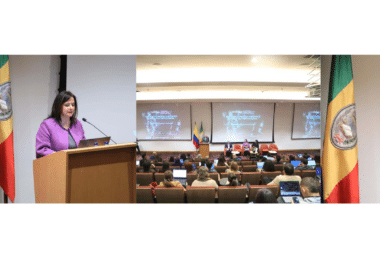1 de julio de 2023
E-commerce and cryptocities
Smart cities are urban areas that leverage technology and data to improve the quality of life for residents, enhance sustainability, and optimize resource management. These cities integrate various Internet of Things (IoT) devices, sensors, and data analytics to gather information and make data-driven decisions. While the concept of smart cities has been around for several years, the future holds exciting possibilities for their development.
The concept of smart cities has its roots in the broader evolution of urban planning and the integration of technology into urban environments. While the term “smart city” gained popularity in recent years, the idea of using technology to improve urban living has been discussed and implemented for several decades. Here’s a brief history of the concept of smart cities:
- 1960s-1970s: The emergence of urban planning theories and technology laid the foundation for smart city concepts. During this period, ideas of integrating computer systems and data processing into urban management started to emerge.
- 1980s-1990s: The introduction of computer networks and advancements in information technology led to the development of “digital cities” or “wired cities” concepts. Researchers and city planners explored the potential of using technology to improve urban services, enhance communication, and enable efficient management of resources.
- 1990s-2000s: The focus shifted towards sustainability and environmental considerations in urban planning. The concept of “eco-cities” gained traction, emphasizing sustainable infrastructure, energy efficiency, and waste management.
- Early 2000s: The term “smart city” started to gain popularity, coinciding with the advancements in the Internet of Things (IoT) and sensor technologies. It was around this time that the integration of digital technologies, data analytics, and connectivity into urban systems became a focal point.
- 2008: The Smart Cities Council, a global consortium of smart city experts and technology companies, was established to promote the adoption of smart city solutions and provide guidance to urban planners.
- 2010s: The idea of smart cities gained significant momentum worldwide. Governments and cities across the globe started investing in smart city initiatives, leveraging technologies such as IoT, data analytics, and artificial intelligence (AI). Numerous pilot projects and initiatives were launched to explore the potential of smart city technologies.
Smart cities have become a prominent agenda item for urban planners, governments, and technology companies. Cities worldwide are implementing various smart solutions, including smart transportation systems, energy management, waste management, and digital services to improve citizen experiences and enhance sustainability.
The concept of smart cities continues to evolve, driven by ongoing advancements in technology and the increasing need for sustainable and efficient urban development. The integration of AI, big data, IoT, and connectivity is expected to shape the future of smart cities, transforming urban environments into more livable, sustainable, and technologically integrated spaces.
Smart cities have a direct relationship with technological paradigms and their changes. The vision of the new urbanism starts from the way in which there is a direct relationship between some of the emerging technologies and the bases of the development of the city as a reality and symbol of communities around the world, as follows:
- Infrastructure management: Smart cities use sensors to monitor and manage infrastructure, such as traffic lights, bridges, and utilities. This data helps in proactive maintenance, reducing downtime, and optimizing resource allocation.
- Sustainable practices: Energy-efficient buildings, smart grids, and renewable energy sources are being implemented in smart cities to reduce carbon footprint and promote sustainability. Efficient waste management and recycling initiatives are also prevalent.
- Intelligent transportation: Smart transportation systems include real-time traffic monitoring, smart parking, and intelligent public transportation. These systems reduce congestion, enhance safety, and improve the overall efficiency of transportation networks.
- Citizen engagement: Smart cities aim to involve citizens in decision-making processes through digital platforms, mobile applications, and social media. This engagement enables residents to provide feedback, report issues, and participate in community activities.
Although it is impossible to predict the next developments for digital urbanism, a prospective exercise allows us to determine that some technological paradigms can contribute to the objective of having more sustainable cities and with a better perspective for economic development, as shown below:
- 5G and connectivity: The widespread implementation of 5G networks will revolutionize smart cities by enabling faster data transmission, lower latency, and connecting a vast number of IoT devices. This will facilitate real-time analytics, autonomous vehicles, and seamless connectivity.
- Artificial Intelligence (AI) and automation: AI-powered systems will play a vital role in managing and analyzing vast amounts of data generated in smart cities. Automation will enhance efficiency in various sectors like transportation, energy management, and public services.
- Improved public safety: Smart cities will leverage advanced surveillance systems, facial recognition technology, and predictive analytics to enhance public safety. These systems can detect anomalies, prevent crimes, and respond quickly to emergencies.
- Health and wellness: Smart cities will prioritize the health and well-being of residents. Sensors and wearables will track health data, and AI algorithms will provide personalized recommendations for healthier lifestyles. Telehealth services and remote monitoring will become more prevalent.
- Sustainable infrastructure: Future smart cities will focus on sustainable infrastructure design, integrating green spaces, and promoting eco-friendly practices. Renewable energy generation, water management, and smart grid systems will be further optimized.
- Enhanced mobility: Autonomous vehicles and shared mobility services will become mainstream in smart cities, reducing congestion, enhancing transportation efficiency, and improving accessibility for all residents.
- Data privacy and cybersecurity: As smart cities rely on vast amounts of data, privacy and security measures will be paramount. Robust cybersecurity protocols and legislation will protect sensitive information and ensure trust among residents.
- The development and implementation of smart cities depend on various factors like funding, technological advancements, and policy frameworks. However, with ongoing progress in technology and the increasing demand for sustainable urban living, smart cities are expected to continue evolving and transforming our urban landscapes in the years to come.
Public services play a crucial role in the development and functioning of smart cities. Here are some pros and cons associated with the integration of public services in smart cities:
Pros:
Efficiency and cost savings: Smart cities leverage technology and data to optimize public services, leading to increased efficiency and cost savings. For example, smart energy management systems can reduce energy consumption, smart waste management can optimize garbage collection routes, and smart transportation systems can improve the efficiency of public transit.
Improved service delivery: Smart city technologies enable real-time data collection, analysis, and monitoring, allowing public services to be delivered more effectively. For instance, smart traffic management systems can alleviate congestion, while smart healthcare systems can provide personalized and timely care.
Enhanced citizen engagement: Smart cities offer digital platforms and mobile applications that facilitate citizen engagement and participation in public services. Citizens can access information, provide feedback, and report issues more easily, leading to improved service responsiveness and accountability.
Sustainability and environmental benefits: Smart cities promote sustainable practices through efficient resource management. Smart grids, renewable energy sources, and optimized waste management systems reduce environmental impact and contribute to a greener and more sustainable urban environment.
Improved quality of life: By leveraging technology and data, smart cities aim to enhance the overall quality of life for residents. From smart healthcare systems to smart public safety initiatives, these cities prioritize the well-being and safety of their citizens.
Cons:
Privacy concerns: The extensive use of technology and data collection in smart cities raises privacy concerns. Citizens may worry about the collection and usage of their personal data, especially if not properly protected or regulated. Striking a balance between data-driven services and privacy protection is crucial.
Technological dependency: Smart cities heavily rely on technology infrastructure and connectivity. System failures, cyber-attacks, or network disruptions can hinder the smooth operation of public services. Adequate backup systems and cybersecurity measures are necessary to mitigate these risks.
Affordability and accessibility: Implementing smart city initiatives can be expensive, and there’s a risk of creating a digital divide if access to technology and digital services is limited. Ensuring affordability and accessibility for all residents is a challenge that needs to be addressed.
Skill requirements and digital literacy: Smart city technologies require a skilled workforce to develop, implement, and maintain them. Ensuring that residents have the necessary digital literacy skills to access and benefit from smart city services is essential. Efforts should be made to bridge the digital divide and provide adequate training and support.
Limited human interaction: As smart cities automate and digitize public services, there may be a reduction in direct human interaction. While this can improve efficiency, it may also lead to a loss of personal connection and a sense of community. Balancing technology with the need for human touch is important.
The implementation of smart city initiatives requires careful planning, stakeholder engagement, and continuous evaluation to maximize the benefits and mitigate the challenges associated with public services in smart cities.
Smart cities generate vast amounts of data through sensors, IoT devices, and digital platforms. While this data is valuable for optimizing services and improving urban life, it also presents challenges in terms of data protection and privacy. Here are some key challenges associated with data protection in smart cities:
Data privacy: Smart cities collect a wide range of personal data, such as location information, transportation patterns, and shopping habits. Protecting individuals’ privacy and ensuring that their personal information is used ethically and securely is a significant challenge. Striking a balance between data collection for service optimization and safeguarding individual privacy rights is crucial.
Consent and control: Smart city initiatives often involve data collection from various sources, including government agencies, private companies, and citizens themselves. Ensuring that individuals have control over their data and giving them the ability to provide informed consent for data collection and usage is essential. Transparent policies and mechanisms for individuals to manage their data preferences are needed.
Data security: The large-scale data collection and interconnectedness in smart cities increase the risk of data breaches and cyber-attacks. Smart city infrastructure must have robust security measures in place to protect data from unauthorized access, tampering, and misuse. Encryption, secure authentication protocols, and regular security audits are necessary to safeguard sensitive information.
Data sharing and governance: Smart cities often involve multiple stakeholders, including government agencies, private companies, and research institutions. Establishing clear guidelines and frameworks for data sharing, usage, and governance is crucial. Collaboration between stakeholders and the development of comprehensive data sharing agreements can ensure responsible and secure data practices.
Algorithmic bias and fairness: Smart city systems rely on algorithms to analyze and make decisions based on collected data. However, these algorithms may inadvertently perpetuate bias or discrimination if the data used to train them is biased. Ensuring fairness and mitigating algorithmic biases are critical to avoid exacerbating existing social inequalities.
Lack of awareness and education: Many citizens may not fully understand the extent of data collection and its potential impact on their privacy. Raising awareness about data protection, privacy rights, and the benefits and risks associated with smart city initiatives is crucial. Educating residents about their rights and providing clear channels for addressing privacy concerns can help build trust and engagement.
Regulatory and legal frameworks: The legal and regulatory frameworks around data protection in smart cities are still evolving. Governments need to develop comprehensive and up-to-date legislation that addresses data protection, privacy, and security in the context of smart cities. This includes establishing clear guidelines for data usage, consent, and accountability for both public and private entities.
Addressing these challenges requires a multi-faceted approach involving collaboration between governments, private sector entities, technology providers, and citizens themselves. By prioritizing data protection, privacy, and transparency, smart cities can ensure that the benefits of data-driven urban development are realized while respecting individual rights and fostering trust among residents.
The intersection of smart cities and e-commerce presents numerous opportunities for both sectors. Here’s an overview of the present and future relationship between smart cities and e-commerce:
Present:
- Digital marketplaces: Smart cities provide a conducive environment for the growth of digital marketplaces and online platforms. E-commerce platforms enable residents to shop online, access a wide range of products and services, and enjoy the convenience of doorstep delivery.
- Delivery optimization: Smart cities leverage technology, such as GPS tracking and real-time data analysis, to optimize e-commerce deliveries. Efficient last-mile delivery systems, drone deliveries, and intelligent logistics solutions are being implemented to enhance delivery speed, accuracy, and reduce congestion.
- Smart lockers and pickup points: E-commerce companies are collaborating with smart cities to establish smart lockers and pickup points. These secure and automated lockers enable convenient delivery and pickup of online purchases, reducing the need for traditional home deliveries and enhancing overall delivery efficiency.
- Data-driven insights: Smart cities generate vast amounts of data on consumer behavior, traffic patterns, and preferences. E-commerce companies can leverage this data to gain valuable insights into customer preferences, optimize product offerings, and tailor marketing strategies.
Future:
- Personalized shopping experiences: As smart cities collect and analyze data on consumer behavior, e-commerce platforms can use this information to offer highly personalized shopping experiences. AI algorithms can provide tailored product recommendations, customized pricing, and personalized marketing campaigns based on individual preferences and needs.
- Augmented reality (AR) and virtual reality (VR): Smart cities will embrace AR and VR technologies, enabling immersive e-commerce experiences. Shoppers will be able to virtually try on clothes, visualize furniture in their homes, or experience products before making a purchase decision, enhancing the online shopping experience.
- Smart payment systems: The integration of smart city infrastructure with e-commerce will lead to advanced payment systems. Contactless payments, mobile wallets, and biometric authentication will become more prevalent, providing secure and seamless transactions.
- Hyperlocal e-commerce: Smart cities facilitate hyperlocal e-commerce, where products and services are sourced and delivered within specific geographic areas. This model reduces delivery times, supports local businesses, and promotes sustainable practices by minimizing transportation distances.
- Integration with Internet of Things (IoT): The IoT will play a significant role in the future of smart cities and e-commerce. Connected devices and sensors can enable automatic reordering of products, smart appliances that replenish supplies, and seamless integration between physical and digital shopping experiences.
- Sustainability and circular economy: Smart cities will promote sustainable e-commerce practices, focusing on reducing waste, optimizing packaging, and supporting the circular economy. E-commerce companies will explore eco-friendly packaging, product recycling, and green supply chain practices to minimize their environmental impact.
- Social commerce and community engagement: Smart cities can foster community engagement through e-commerce platforms. Local businesses and artisans can connect with residents through digital marketplaces, social commerce, and online community platforms, promoting economic growth and supporting local entrepreneurship.
CryptoCities and e-commerce
While the integration of smart cities and e-commerce offers numerous benefits, challenges like digital divide, data privacy, and cybersecurity need to be addressed. Continued collaboration between smart city authorities, e-commerce companies, and relevant stakeholders is essential to unlock the full potential of this relationship and ensure equitable access and sustainable growth.
Cryptocities are embracing disruptive payment methods as part of their efforts to create seamless and efficient urban environments. Disruptive payment methods are innovative, technology-driven solutions that challenge traditional payment systems and offer new ways for individuals to make transactions. Here are some examples of how cryptocities are incorporating disruptive payment methods:
- Contactless payments: Cryptocities are adopting contactless payment technologies such as Near Field Communication (NFC) and Radio Frequency Identification (RFID). These payment methods enable residents to make transactions simply by tapping their smartphones, smart cards, or wearables on payment terminals. Contactless payments improve convenience, speed up transactions, and reduce the need for physical cash or cards.
- Mobile wallets: Mobile wallet applications, such as Apple Pay, Google Pay, and Samsung Pay, are gaining popularity in smart cities. These digital wallets allow users to store their payment card information securely on their smartphones and make payments by scanning a QR code or using NFC technology. Mobile wallets offer convenience, enhanced security features, and the ability to integrate loyalty programs and digital receipts.
- Biometric payments: cryptocities are exploring biometric payment methods that utilize unique physiological characteristics, such as fingerprints or facial recognition, for authentication and transaction authorization. Biometric payments eliminate the need for physical cards or passwords, providing a more secure and convenient payment experience.
- Blockchain-based payments: Blockchain technology is being integrated into cryptocity payment systems to enhance security, transparency, and efficiency. Blockchain enables peer-to-peer transactions and eliminates intermediaries, reducing transaction costs and enabling faster, more secure payments.
- Tokenized payments: Tokenization involves converting sensitive payment data into a unique identifier or token, reducing the risk of exposing actual payment details during transactions. Cryptocities can implement tokenized payment systems, ensuring secure transactions across various services and platforms within the urban environment.
- Internet of Things (IoT) payments: With the proliferation of IoT devices in cryptocities, payment capabilities can be integrated into these devices. For example, connected vehicles equipped with payment technology can enable drivers to make seamless payments for tolls, parking fees, and charging services.
The integration of disruptive payment methods in smart cities offers several benefits, including increased convenience, faster transactions, enhanced security, and improved efficiency. However, challenges such as infrastructure requirements, interoperability, and ensuring data privacy and security need to be addressed to realize the full potential of these payment innovations. Cryptocities and payment service providers must collaborate to ensure seamless integration and provide reliable and secure payment experiences for residents and visitors.
Concluding remarks
In conclusion, the consolidation of smart cities entails another phase in their development and a paradigmatic change in their concept. Emerging technologies, in particular, blockchain and cryptocurrencies facilitate the introduction of other technologies such as IoT and allow digital urbanism to be considered with new values such as cybersecurity and information protection without losing efficiency in the provision of digital citizen services.
The axis of this epistemological change is based on the recent evolution of electronic commerce that finds in Covid-19 and in a goal of transgenerational digital appropriation the need for a new model based on the new generation of cryptography and encryption techniques with the decentralization that is It has been tested in crypto assets and in the generalization in the use of electronic payments.
Artículos Recientes
¡Ya está disponible el caso! Segunda versión del Concurso Laboratorio de Estrategia Legal #LSL
Invitamos a los estudiantes de pregrado y postgrado de todas las carreras a presentar [...]
Masterclass Legal Operations: Transformando la Función Legal Empresarial de Guardián de Riesgos a Creador de Valor.
El Departamento de Derecho de los Negocios y la Facultad de Administración de Empresas [...]
Conclusión del Proceso de Reforma al Investor-State Dispute Settlement
En la semana del 12 de julio de 2023, durante la sesión anual de [...]
El Departamento de Derecho de los Negocios de la Universidad Externado de Colombia abre convocatoria para la vacante de Asistente de Investigación
¡Sé parte de nuestro equipo de trabajo! Perfil del cargo: Asistente de Investigación Apoyar [...]
Docente del Departamento de Derecho de los Negocios participó en el libro Blanco de la Asociación de Derecho Internacional
La Asociación de Derecho Internacional (ADI), una de la organizaciones más antiguas y prestigiosas [...]
CRYPTO IN COLOMBIA: PROSPECTIVE 2022
By: Daniel Peña Valenzuela The volatility of the main cryptocurrencies seems to be once [...]
Convocatoria de Monitores.
El Departamento de Derecho de los Negocios se complace en anunciar la apertura para [...]
¿Se avecina una regulación de la Franquicia por parte del Gobierno? ¿O lo impedirá la Corte Constitucional?
Por: Juan Miguel Álvarez* y Diana Marcela Araujo* En diciembre del 2020, el congreso [...]
Ciclo de seminarios de Innovaciones en Justicia Digital: un espacio desde la academia que replantea el futuro del sistema de justicia.
El Seminario en Innovaciones en Justicia Digital es un evento de la Universidad Externado [...]
Rostros de mentira: Retos legales producidos por las ‘Deepfakes’
Palabras clave: Deepfake, IA, contenidos audiovisuales, redes generativas adversarias, derecho probatorio, intimidad personal. Una [...]
Memorias: Tercer seminario de innovaciones en la justicia digital- aplicaciones de la inteligencia artificial en la práctica judicial.
El pasado 19 de septiembre de 2024, las instalaciones de la Universidad Externado fueron [...]
Celebramos la realización del 40º Congreso Nacional de Derecho Comercial: Novedades y retos de la contratación mercantil y del arbitraje comercial
El pasado 30 de octubre, en Medellín, se celebró el 40º Congreso Nacional de [...]


















